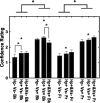Visual and haptic cues in processing occlusion
- PMID: 36968748
- PMCID: PMC10036393
- DOI: 10.3389/fpsyg.2023.1082557
Visual and haptic cues in processing occlusion
Abstract
Introduction: Although shape is effective in processing occlusion, ambiguities in segmentation can also be addressed using depth discontinuity given visually and haptically. This study elucidates the contribution of visual and haptic cues to depth discontinuity in processing occlusion.
Methods: A virtual reality experiment was conducted with 15 students as participants. Word stimuli were presented on a head-mounted display for recognition. The central part of the words was masked with a virtual ribbon placed at different depths so that the ribbon appeared as an occlusion. The visual depth cue was either present with binocular stereopsis or absent with monocular presentation. The haptic cue was either missing, provided consecutively, or concurrently, by actively tracing a real off-screen bar edge that was positionally aligned with the ribbon in the virtual space. Recognition performance was compared between depth cue conditions.
Results: We found that word recognition was better with the stereoscopic cue but not with the haptic cue, although both cues contributed to greater confidence in depth estimation. The performance was better when the ribbon was at the farther depth plane to appear as a hollow, rather than when it was at the nearer depth plane to cover the word.
Discussion: The results indicate that occlusion is processed in the human brain by visual input only despite the apparent effectiveness of haptic space perception, reflecting a complex set of natural constraints.
Keywords: depth cues; haptic perception; image segmentation; virtual reality; visual pathways.
Copyright © 2023 Takeichi, Taniguchi and Shigemasu.
Conflict of interest statement
The authors declare that the research was conducted in the absence of any commercial or financial relationships that could be construed as a potential conflict of interest.
Figures






References
-
- Albalas F., Alzu'bi A., Alguzo A., al-Hadhrami T., Othman A. (2022). Learning discriminant spatial features with deep graph-based convolutions for occluded face detection. IEEE Access 10, 35162–35171. doi: 10.1109/ACCESS.2022.3163565 - DOI
LinkOut - more resources
Full Text Sources

